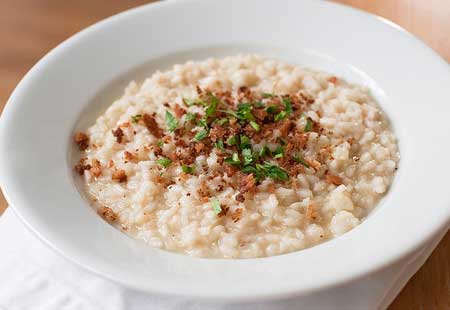Healthy Cauliflower Risotto Recipe
May 18, 2010 Written by JP [Font too small?]This past weekend a client consulted with me about how to select healthier food options when dining out. In practical terms this often means asking for substitutions for starchy and/or sweet food items. For example you can request to have a side of grilled asparagus or wilted spinach instead of pasta or risotto. However this suggestion sometimes segues into a common concern among those trying to lose weight or otherwise improve their health. “You mean I can never eat risotto again?!” The short answer is, “Of course you can”. But the more nuanced response is that such delicacies should probably be saved for special occasions and not be eaten as a regular part of your menu plan.

Another way of making dietary substitutions is by re-creating a recipe with more nutritious ingredients. In the case of risotto, I’ve found that you can carefully modify cauliflower to yield a rice-like consistency. By doing so you effectively transform a side dish that’s normally loaded with starchy carbohydrates into a genuinely healthy, low carb alternative.
Cauliflower is a popular member of the cruciferous family of vegetables which also includes bok choy, broccoli, Brussels sprouts, cabbage, kale and radishes. Recent scientific inquiries have uncovered potent phytochemicals in these “superfoods” which may discourage the formation of a variety of malignancies such as colorectal cancer, lung cancer, lymphoma, ovarian cancer and prostate cancer. (1,2,3,4,5)
On the other hand, frequent white rice consumption is a major contributor to the glycemic index and glycemic load of many unhealthy diets. Not surprisingly, this style of eating has been implicated with the “deterioration of glucose metabolism”, “a high prevalence of type 2 diabetes” and heart disease. (6,7,8)
Cauliflower Risotto
20 oz of frozen cauliflower florets
3 oz of organic half and half
3 oz of Asiago, Fontina & Parmesan shredded cheese
3 cloves of garlic
NutraSalt or salt to taste
Freshly ground pepper to taste
Nutritional Content: Calories: 140. Protein: 6 grams. Fat: 8 grams. Fiber: 3 grams. “Net” Carbohydrates: 2 grams. Total Servings: 5.
Thaw two 10 oz packages of frozen cauliflower in a colander. Place the drained, thawed cauliflower florets in a food processor and pulse (on the chop” setting) until they reach the consistency of rice granules. Mince 3 garlic cloves. Place one tablespoon of organic butter and one tablespoon of organic extra virgin olive oil into a sauce pan and heat on a low-medium setting for about one minute. Add the “cauliflower rice” to the garlic-oil mixture and stir well. Salt and pepper to taste. Cover and cook for about 10 minutes, stirring several times along the way. Add the half-and-half and cheese blend and incorporate well. Continue to cook and stir for an additional 3 minutes or so without the cover on.
| Food Sources of Selected Phytochemicals with Possible Chemopreventive Properties | ||
| Glucosinolate (precursor) | Indole or Isothiocyanate | Food Sources |
| Glucobrassicin | Indole-3-Carbinol
 |
Broccoli, Brussels sprouts, Cabbage, Cauliflower |
| Glucoraphanin | Sulforaphane
 |
Broccoli sprouts, Broccoli, Brussels sprouts, Cabbage |
| Gluconasturtiin | Phenethyl-Isothiocyanate
 |
Watercress |
| Glucotropaeolin | Benzyl-Isothiocyanate
 |
Cabbage, Garden cress, Indian cress |
| Sinigrin | Allyl-Isothiocyanate
 |
Cabbage, Horseradish, Mustard |
The proposed chemoprotective properties of cruciferous vegetables are fairly well established in the medical literature. But these powerhouse veggies shouldn’t only be thought of as cancer fighters. Several recent studies specifically single out vegetables such as cauliflower as having a positive impact on brain-related conditions as well. A paper published in the April 2010 edition of the Archives of Neurology includes cruciferous vegetables in a list of foods that may confer a preventive effect with regard to Alzheimer’s disease (AD). The remaining members of the noted AD-protective diet also includes dark green leafy vegetables, fish, nuts, poultry and tomatoes. A trial appearing in the October 2009 issue of the British Journal of Nutrition concluded that higher intakes of crucifers reduced the risk of cerebrovascular disease by 21%, ischaemic stroke by 33% and intracerebral haemorrhage by 51% in a group of 3,932 middle-aged and senior men and women. Finally, an experiment presented in the journal Neuroscience Letters determined that administering sulforaphane, a phytochemical present in cruciferous vegetables, improved recovery from traumatic brain injury and enhanced cognition in an animal model. (9,10,11)
It should be noted that hypothyroid individuals are often cautioned against eating large amount of crucifers because they’re rich sources of goitrogens which can interfere with thyroid hormone production. However, the cooking process and maintaining adequate iodine intake may reduce this thyroid-specific threat. Still, anyone with a diagnosed or suspected thyroid disorder should consider discussing this issue further with their health care providers just to be on the safe side. (12,13,14,15,16)
You can include cauliflower risotto in meals just as you would traditional risotto. It’s a great accompaniment to any type of grilled fish, roasted chicken and even stewed beef or pork. And since you’re using it as a replacement for a starchy element, it still allows you to add an extra vegetable to your meal if you so choose. Picture this on a plate: slow cooked short ribs in a rich, reduction sauce and a side of roasted asparagus on top of a small mound of cauliflower risotto. Pour yourself a glass of biodynamic or organic red wine and you have yourself a feast that will nourish your body and mind. Now that’s my idea of being on a “diet”.
Be well!
JP
Tags: Cancer, Heart Health, Thyroid
Posted in Diet and Weight Loss, Nutrition

May 18th, 2010 at 10:25 pm
Hi JP!
I am always answering that question too.
“You mean I can never have X, Y, Z again?”
People eat 5 or 6 servings of rice – not just a half cup – at a time.
Even the largest stomach would have to stretch just to accomodate the volume of food…
much less the calories – that some people eat.
Love the cauliflower risotto idea!
When’s dinner?
May 19th, 2010 at 2:09 am
Good Morning, JP 🙂
im coming for dinner too 😉
I have additional news, because of the word *risotto*:
i bought a risotto-spice at my “wholefoods” its called “Trüffelglück” which means “black truffle-heaven” 🙂 i love the taste of black or white truffle. In this spice is powdered black truffle, maitake, porcino and a few other fungi, a little bit of garlic and thats it. The fungis deliver the main taste.
I think i will try your risotto, adding a few fresh fungis and my new spice :-). The creator of this also recommend it for salad, i tried and it is soooo yummy!
Another good idea for a do-it-yourself spice would be to by dried organic fungi and then powder them with a food processor, good for sauces etc..
…so guess what im gonna cook today 🙂
Nina K.
May 19th, 2010 at 12:43 pm
Anne,
That’s a good point about the typical serving size of rice. It’s easy to overdo it!
Dinner is anytime you stop by! Give us a heads up and we’ll make some fresh risotto! 🙂
Be well!
JP
May 19th, 2010 at 12:46 pm
That sounds delicious, Nina! I’ll bet my wife would love that!
Recently she took a trip to the Napa Valley and returned with a container of decadent black truffle sea salt. What incredible flavor! A real treat!
I hope you enjoy the cauliflower risotto – if you try it. I’m sure adding the “Trüffelglück” will only enhance the flavor!
Be well!
JP
May 19th, 2010 at 3:02 pm
JP,
“You mean I can never eat risotto again?!”
Responses like these are somewhat irritating because of many people’s inclination to treating a condition with extremeness. “Of course you can eat risotto,” I’d say, “but like anything else, moderation is key.” Your recipe seems to find that balance. Thanks for sharing.
Regards,
Steve
May 19th, 2010 at 3:03 pm
I have to make this soon!
May 19th, 2010 at 10:28 pm
Thank you, Steve.
I appreciate your input.
Be well!
JP
May 19th, 2010 at 10:30 pm
I hope you enjoy it if you try it, Angie!
We just had some tonight. We put a sunny side up egg on top of some of the cauliflower risotto and enjoyed it with a few slices of organic bacon. Breakfast for dinner. We loved it. 🙂
Be well!
JP
May 21st, 2010 at 12:30 am
I made this and I have to say, it’s about 10 times better than I thought it would be… and I already had high expectations!
I told my mom, Move over Rice a Roni… I thought I died and went to San Fran!
May 21st, 2010 at 6:26 pm
That’s great news! Thank you so much for trying it out and letting me know, Angie! 🙂
More recipes to come …
Be well!
JP
September 14th, 2010 at 1:29 pm
What a vegetable this is. I love how versatile cauliflower is. I so tempted to try your recipe later this week (I have 3 heads of cauliflower waiting for me at home.) I will come back to your site and report on how your recipe turned out for sure! Would you like to take a look at my most recent cauliflower creation? http://cuceesprouts.com/2010/09/marinated-cauliflower-salad/
September 14th, 2010 at 1:40 pm
Great. Looking forward to your review. 🙂
I’m off to check out your recipe now.
Be well!
JP